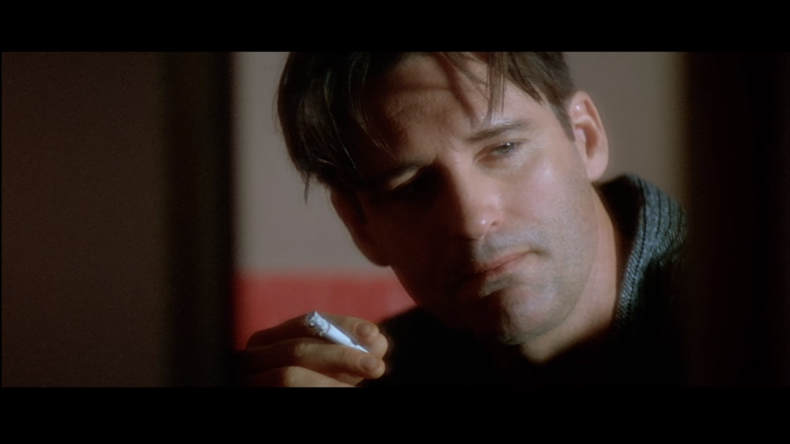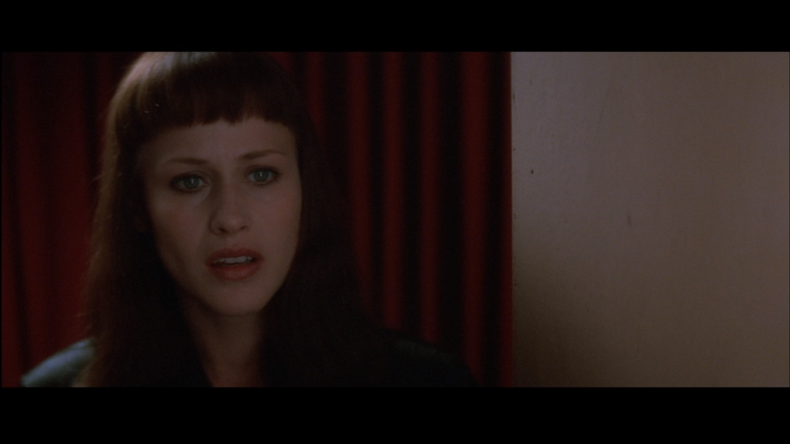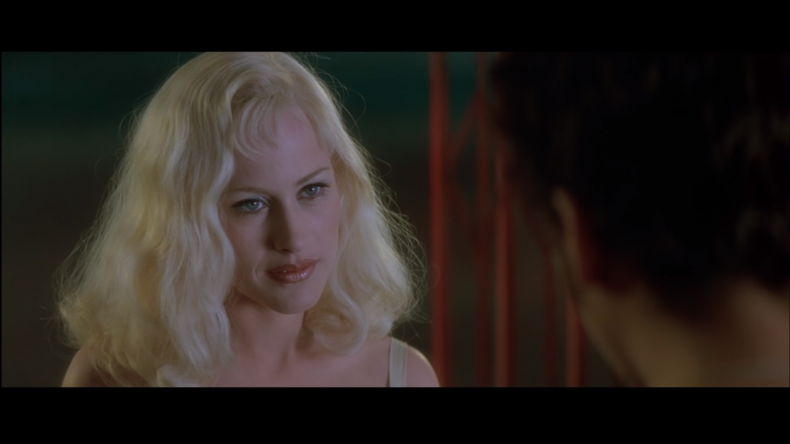Tremors of postmodern spectatorship.
Tremors of postmodern spectatorship.
Notes on David Lynch’s LOST HIGHWAY
“(M)odern theory requires a critical distance - a position from which it can ‘speak’ in order to judge and value the text” (Hil/ Every 1998). In response to the neglect of female subjectivity in Lost Highway, I choose to speak from the subjective I.
“I think I’m paranoid, MANipulated” (Garbage 1998). A case of hysteria: Postmodern spectatorship.
Breton and Aragon “define hysteria as a ‘mental state’ based on a ‘reciprocal seduction’ that subverts all relations ‘between the subject and the moral world’. ... (T)he hysteric is a paragon of a liberated love that, ... suspends rational relations and that, ... shatters moral subjecthood. In a sense, it is a form of ecstasy, and the ‘seduction’ is ‘reciprocal’: it produces its effects in others - in doctor or analyst, in artist or viewer” (Foster 1993).
The following paper positions LOST HIGHWAY as a postmodern text. Postmodernist in the Frederic Jameson sense, in that it “unwittingly or otherwise, (is) in collusion with the powers-that-be in helping to maintain the political status quo” (Sim 1998) In the context of the cinema and this paper, that maintenance I am referring to is that of the dominant model of spectatorship, the masculine structured gaze. I argue that Lost Highway does this by employing an aesthetic of hysteria to create a space of ambiguity within the text. This ambiguity is used strategically to produce a moral contradiction in the spectator, throwing him or her into a state of hysteria.
“Suspending my rational relations, and shattering my moral subjecthood”, I want to see the film again and again. I’ve been seduced. This paper maps the trap of LOST HIGHWAY. A trap which seduces me, possesses me, only then to snuff me out.
Fred Madison, the protagonist of LOST HIGHWAY suffers from hysteria. “I like to remember things my own way... How I remembered them. Not necessarily the way they happened” says Fred who is played by Bill Pullman. This provides a key to the narrative’s open architecture, which physicalizes the simultaneously parallel worlds of Fred’s delusions and the diegetic reality outside of his delusions. They can’t be separated. This ambiguity works in resisting the spectators ability to reduce the narrative into any definitive and rational account of what happened.
“Freud drew attention to the fragmentary and discontinuous nature of the hysteric’s narrative and to the physician’s responsibility for reorganizing it into a coherent whole” (Showalter 1997). In so doing, the physician has to fill in the gaps ofthe hysteric’s story, and thus the narrative would illustrate thedoctor’s hysteria rather than the patient’s. Filling in the gaps of LOST HIGHWAY, I wonder whose hysteria this is. Is it Fred’s hysteria coming through Freud ... or mine?
In interviews Lynch has invoked André Breton as a mentor (Warner 1997). Breton and Aragon claimed the disorder of hysteria for the world of aesthetics, expressing that hysteria “can in every way be considered a supreme mode of expression” (Aragon/ Breton 1948). In LOST HIGHWAY hysteria functions as the central organizing trope of the narrative. Yet it also functions as Fred’s “physical, verbal and gestural language” (Micale 1994). It is within this language that we witness the collapse of “the boundaries and bridges” (Porter 1994) between Fred’s mind and body. It is in dialogue with this language, that I witness the collapse of “the boundaries and bridges” in the union of Fred’s mind and body and my mind and body.
LOST HIGHWAY takes place in the mind of Fred. Therefore as the spectator we know and we see through Fred. My relationship with the screen, is a relationship with Fred. I don’t know if he wants to fuck me or kill me. I don’t know if his masculinity is in crisis or whether he employs a plea of hysteria as an alibi to evade the charge of misogyny. I tremor.
The masculine structured gaze of the cinema is the paradigm of Fred’s subjectivity. Naturally then, in classic tradition Fred would believe that his relationship with his wife Renee, played by Patricia Arquette, should be one where he possesses her through his phallic gaze, she should be his property. Yet Fred is paranoid that Renee is having an extra marital affair, that he does not possess her at all. The text ambiguously structures whether the paranoia is delusional or not. As the narrative is told through Fred’s minds eye, the perception of his reality cannot be trusted. As a spectator, I have no fixed point of reality to read from, this decenters me. From here on in, it becomes impossible to decipher reality from delusion. One would think that this lack of authority of Fred’s gaze would begin to fracture what Kaja Silverman has called the “dominant fiction of phallic wholeness” (Silverman 1992).
Fred’s anxiety is displaced from his impotence onto Renee’s supposed infidelity. His hysteria articulates a loss of control over ‘his’ female body. This lack of possession throws his masculinity into a state of crisis. Yet under the surface, what exists, is a violent reassertion of that phallic wholeness. The only way he can reassert his power, his phallic gaze, is by possessing her in the only way he can, murder.
Fred’s misogyny is revealed through reading his train of thought. In one scene Fred lies in bed and has a flashback or delusion of him playing saxophone at a club. Fred watches as Renee leaves the club with another man. This flashback or delusion is interrupted when Renee gets into bed and they start to make love. Fred does not successfully sexually perform and he turns away from Renee and tells her of a dream he had, one which foretells her muder of her. What Fred’s thought process exposes is that, wife’s infidelity + husband’s impotence = husband’s desire to murder wife.
While on death row for murdering Renee, Fred undergoes his most serious expression of the loss of his subjectivity: he metamorphoses into Pete Dayton, played by Balthezer Getty. Fred undergoes a hysterical fugue, which is when a person “may suddenly leave what (s/)he is doing and go on a journey which (s/)he cannot remember afterwards” (Monton 1985). David Lynch describes a psychogenic fugue as “a person (who) gives up himself, his world, his family - everything about himself - and takes on another identity” (Pizello 1997). So, for some time, Fred Madison becomes Pete Dayton, or due to its ambiguous nature, it could be that Pete Dayton becomes Fred Madison.
Pete Dayton falls for Alice Wakefield who is also played by Patricia Arquette. Arquette has described her performance as “two different interpretations of the same woman. I think it’s about a man trying to recreate a relationship with the woman he loves so that it ends up better” (Rodley 1996). Arquette goes on to explain that her characters are about “the darkness of women. The destructive element of women. It’s a man’s concept” (ibid.). Arquette also reads the text as the hysterical narrative belonging to Fred’s mind, a mind which bases its subjectivity on the structured male gaze of dominant cinema.
Postmodern cinema knows the history and codes of spectatorship, and employs them according to its agenda. LOST HIGHWAY exposes this knowledge, utilizing it as a frame to simultaneously subvert and revive. The classical model of spectatorship is in fact the diegetic landscape of the film.
Throughout this scene, Alice is in control of the narrative, since she initiates the flashback. This traditionally dictates that it would be the way Alice remembered things. Her voice-over places her in a position of authority. Speaking for herself, Alice tells a dirty story, and she obviously likes it. But if this is taking place in Fred’s mind, then isn’t Fred putting words into Alice’s mouth? Like phone sex, Alice tells Pete, who fills in the pictures, a dirty story. Fred/Pete ask Alice whether she enjoyed being forced to strip at gun point in front of a room full of men. Alice doesn’t answer, but I know she did enjoy it, because I felt her tremor.
When questioning how the female spectator would identify with the masochistic scenario, Parveen Adams suggests “that she does not necessarily identify only and exclusively with the woman who is beaten; she may also, simultaneously, identify with the beater or with the less involved spectator who simply looks on. And even if she does identify only with the tortured woman, she might identify alternately or simultaneously with her pleasure and/or her pain” (Williams 1989).
If the text is Fred’s mind’s eye, then so too are the videotapes in the diegesis extensions of this. That Fred’s mind’s eye should have to be played through the televisual apparatus is revealing of Fred’s reliance on the modernistic spectatorial model for his subjectivity. It is not until Fred watches the murder on screen that he is made aware of his deranged actions. Fred is clearly aligned with the active look of the camera. His minds eye, the video camera, has recorded Renee as physically fragmented. Her body, chopped into pieces, is unable to look back. Fred makes, and watches, his own snuff movie of Renee. He snuffs her out. Not willing to accept the sadist position, I too have nowhere to view from but to be snuffed out. Either position is a troubled identification for the spectator.
While Fred suffers a fragmentation of the mind, Renee suffers a fragmentation of body. Woman as image, as object of desire, is kept in place. Fred gets to hold and control the object of the phallic gaze. He chops Renee into pieces, only to rearrange her as Alice. This recreation of Renee through Alice is a form of necrophilia. “What I needed to have was a particular experience with a person”, said Edmund Emil Kemper the III who was a necrophilic killer, “to possess them in the way I had to, I had to evict them from their bodies” (Simon 1996, 293). “Necrophilic sexual psychopaths derive sexual gratification only when they can have complete command of a woman’s body without the woman present. The total sense of power acts like an aphrodisiac but also dispels fears of inadequacy with women” (ibid., 44). The necrophile rids the female body of its mind. To possess Renee in the way Fred had to, he had to evict her from her body. Fred possesses Renee in his look, but it’s all in his head.
Postmodern film employs a strategic aesthetic of ambiguity to simultaneously allow “the definitive end and overcoming of modern(ist) spectatorship, and, at the same time, modern(ist) spectatorship under new management” (Spencer 1998). I don’t know if he wants to fuck me or kill me. “I feel paranoid and complicated. I feel paranoid and MANipulated” (Garbage 1998). I’m hysterical and I want more. Cinema makes me tremor.
Aragon, Louis/ Breton, André (1948) Le cinquantenaire de l’hysterie (1878-1928), in: Maurice Nadeau (ed.) (1948) Histoire du surrealisme: Documents surrealistes, Paris: Seuil, p.125
Foster, Hal (1993) Compulsive Beauty, Cambridge MIT Press, p.50
Garbage (1998) I think I’m paranoid, Version 2.0, Mushroom International BV
Hil, Val/ Every, Peter (1998) Postmodernism and the cinema, in: Stuart Sim (ed.), (1998) The Icon Critical Dictionary of Postmodern Thought, Cambridge: Icon Books, p.103
Micale, Mark S. (1994) Approaching Hysteria, Princeton: Princeton University Press, p.182
Monton, Edgar A. (1985) Hysteria. Its causes, symptoms snd treatment, Surrey: Roseneath Scientific Publications, p. 133
Pizzello, Stephen (1997) Highway to Hell, in: American Cinematographer, Vol. 78, No 3, March 1997, p.36
Porter, Roy (1994) The Body and the Mind, the Doctor and the Patient: Negotiating hysteria, in: Sander Gilman, H. King, R. Porter, G.S. Rousseau, E. Showalter (eds.) (1994) Hysteria Beyond Freud, Berkeley: University Press, p.182
Rodley, Chris (1996) David Lynch: Mr Contradiction, in: Sight and Sound, Volume 6: Issue 7, July 1996, p. 10
Showalter, Elaine (1997) Hystories: Hysterical Epidemics and Modern Culture, New York: Columbia University Press, p.85
Silverman, Kaja (1992) Male Subjectivity at the Margins, New York: Routledge
Sim, Stuart (1998) Postmodernism and Philosophy, in: Stuart Sim (ed) (1998) The Icon Critical Dictionary of Postmodern Thought, Cambridge: Icon Books, p.13
Simon, Robert I. (1996) Bad Men Do What Good Men Dream, Washington: American Psychiatric Press
Warner, Marina (1997) Voodoo Road, in: Sight and Sound, Volume 7: Issue 8, August 1997, p .6
Williams, Linda (1989) Hard Core. Power, Pleasure, and the Frenzy of the Visible, Berkeley: University of California Press, p.215
Spencer, Llyod (1998) Postmodernism, Modernity, and the Tradition of Dissent, in: Stuart Sim (ed.) (1998) The Icon Critical Dictionary of Postmodern Thought, Cambridge: Icon Books, p.161





